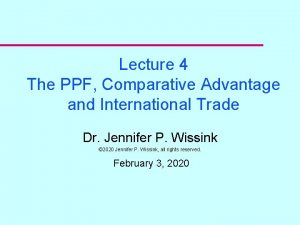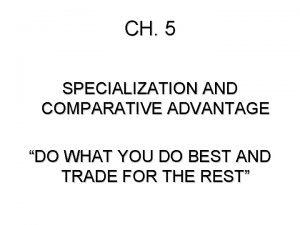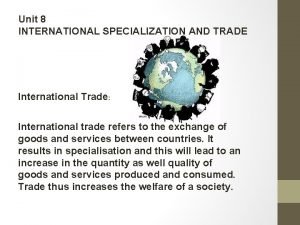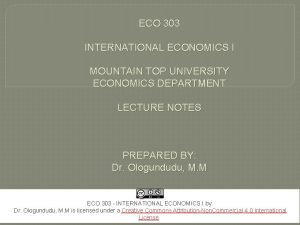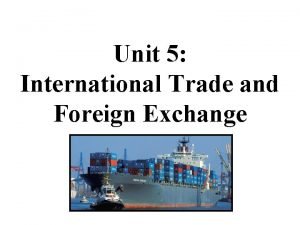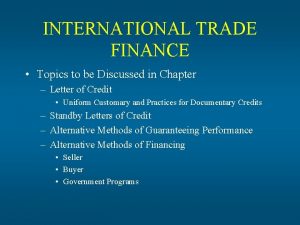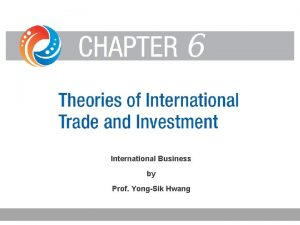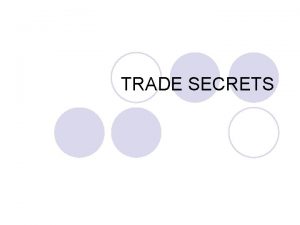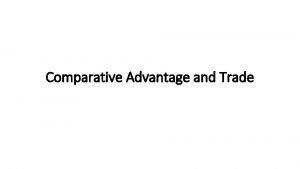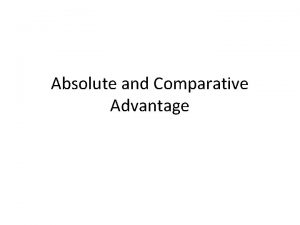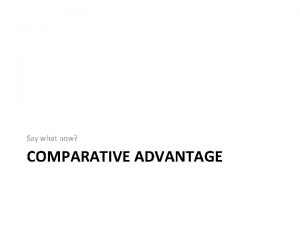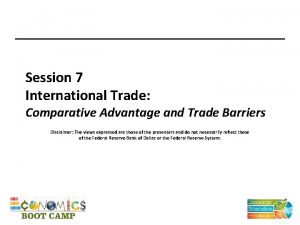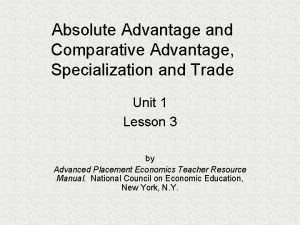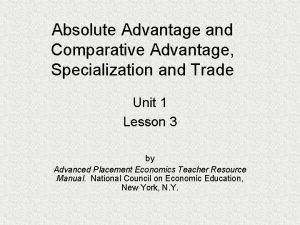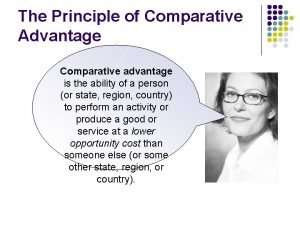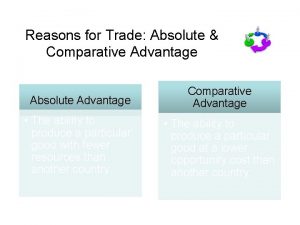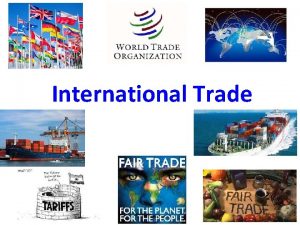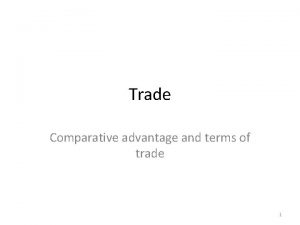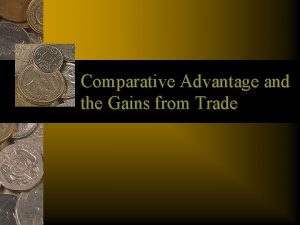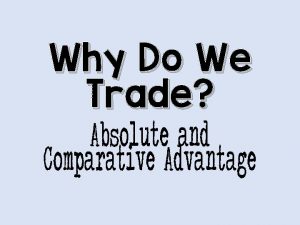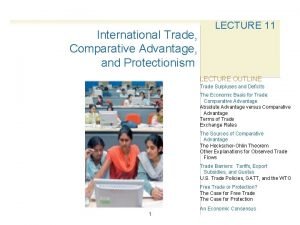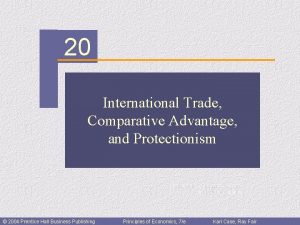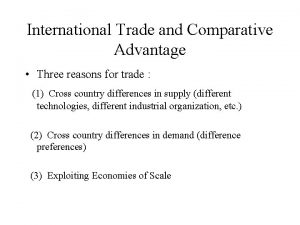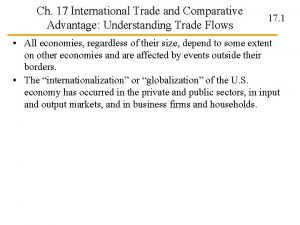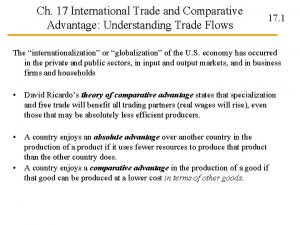11 International Trade and Comparative Advantage Outline Why























- Slides: 23

11 International Trade and Comparative Advantage

Outline ● Why Trade? ● International versus Intranational Trade ● The Law of Comparative Advantage

Puzzle: How Can Americans Compete with “Cheap Foreign Labor”? ● Why do Americans want government to limit or prevent import-competition? ♦ Common belief that imports ↓ U. S. jobs and wages. ♦ “Cheap foreign L” steals jobs from U. S. L and puts pressure on U. S. firms to cut wages. Copyright© 2006 Southwestern/Thomson Learning All rights reserved.

“Cheap Foreign Labor” ● Empirical evidence doesn’t support this view. ♦ ↑wages in industrialized countries that X to U. S. over past 30 years. ♦ Wages in Britain rose from ½ U. S. standards to above U. S. levels. ♦ Wages in South Korea have dramatically increased from just 5% of U. S. wages to nearly 60% –all during a time when X of textiles, toys, and consumer electronics soared. ♦ Clearly, cheap L abroad does not explain our ↑ trade deficit. Copyright© 2006 Southwestern/Thomson Learning All rights reserved.

TABLE 1. Labor Costs in Industrialized Countries 1975 2005 73% 104% United Kingdom 54 109 Spain 41 75 Japan 48 92 South Korea 5 57 Taiwan 6 27 Mexico 24 11 Canada 99 101 France Note: Labor costs in industrialized countries as a percentage of U. S. Labor Costs

Why Trade? ● Differences in resources ♦ U. S. can produce coal and wheat but relies on rest of the world for rubber and oil. ♦ Saudi Arabia has poor farming T but sits on a massive pool of oil. ● Differences in climate ♦ Bananas and coffee are more efficiently grown in Latin America. Copyright© 2006 Southwestern/Thomson Learning All rights reserved.

Why Trade? ● Differences in labor skills ♦ New Zealand has skilled sheep farmers, while Singapore has skilled manufacturing workers. ● Economies of Scale ♦ Small country that tried to produce everything for itself would end up with many industries whose scale of operation was too small to benefit from mass-scale production techniques. ♦ Argentina does not have enough domestic consumers to support 1 efficient scale automobile producer. Copyright© 2006 Southwestern/Thomson Learning All rights reserved.

Mutual Gains from Trade ● Late 1700 s, Adam Smith and David Ricardo argued that 2 countries must gain from voluntary exchange. If not, they would refuse to trade. ● Exchange of goods ↑ welfare of two parties, even though no goods are created in the act of trading. ♦ U. S. and Mexico are both better off if Mexico ships fruits and vegetables in exchange for telecommunications equipment. Copyright© 2006 Southwestern/Thomson Learning All rights reserved.

Intranational Trade ● 50 states in U. S. with no trade barriers shows the incredible gains from specialization and trade. ♦ ♦ ♦ California –movies and computer chips Wisconsin –beer and cheese Michigan –cars Nebraska –corn Florida –oranges New York –financial services ● Your standard of living would be much lower if you were only allowed to purchase goods made in CA. Copyright© 2006 Southwestern/Thomson Learning All rights reserved.

International versus Intranational Trade ● Political factors ♦ Domestic trade occurs under one government. ♦ U. S. Constitution prohibits trade restrictions across states. ● Many currencies ♦ Trade in U. S. (or EU) is carried out with same currency. ● Restrictions on L and K mobility ♦ No immigration laws restrict flow of L across state borders. ♦ Many countries have laws that restrict foreign ownership of domestic assets. ♦ K invested abroad faces greater risks of expropriation. Copyright© 2006 Southwestern/Thomson Learning All rights reserved.

The Law of Comparative Advantage ● Gains from trade are obvious when 1 country is better at producing 1 good and its trading partner is better at producing another. ♦ U. S. X aircraft to Columbia in exchange for coffee. ♦ U. S. has more K equipment and experience with aircraft production and Columbia has cheaper L and a warmer climate. ♦ U. S. has an absolute advantage in aircraft production and Columbia has an absolute advantage in coffee production. Copyright© 2006 Southwestern/Thomson Learning All rights reserved.

The Law of Comparative Advantage ● Less obvious: if 1 country is better at producing everything, then 2 countries can gain from trade. ♦ E. g. , Top neurosurgeon who is the best car mechanic. Should she repair her own car? No! Even though she’s a better car mechanic, she should concentrate on surgery and leave car repair to a lower skilled (and lesser paid) auto mechanic. Opportunity cost of 1 hour devoted to car repair is 1 less hour spent in brain surgery which is higher paying. ● Comparative advantage is at work here. Surgeon specializes in medicine despite her absolute advantage in car repair because she has an even greater absolute advantage as a doctor. Copyright© 2006 Southwestern/Thomson Learning All rights reserved.

The Law of Comparative Advantage ● Law of comparative advantage: even if one country is worse at producing every good, relative to another country, it has a comparative advantage in making the good at which it is the least inefficient. ● A country can gain importing a good, even if that good could be produced at home more efficiently than it could be produced abroad. These imports allow the country to specialize in goods at which it is even more efficient. Copyright© 2006 Southwestern/Thomson Learning All rights reserved.

Arithmetic of Comparative Advantage ● Trade Model: 2 countries –U. S. and Japan; 1 input –L; and 2 goods –computers and televisions ● Assume U. S. has absolute advantage in producing both goods. It still pays for U. S. to trade with Japan. ● In Table 2, U. S. has a comparative advantage in PCs and Japan has a comparative advantage in TVs. ● U. S. is 5 times more efficient in PCs and 1. 25 times as efficient in TVs. Copyright© 2006 Southwestern/Thomson Learning All rights reserved.

TABLE 2. Alternative Outputs from One Year of Labor Input

Graph of Comparative Advantage ● Assume U. S. and Japan have same amount of L – 1 million person years. ♦ Actual graph for U. S. would be even further out from Japan because U. S. has more L. Here we want to highlight the differences in L efficiency. ● Absolute advantage is shown by PPF of U. S. lies outside PPF for Japan. ♦ U. S. can produce more of both goods using same amount of L. Copyright© 2006 Southwestern/Thomson Learning All rights reserved.

Graph of Comparative Advantage ● Comparative advantage is shown by the relative slopes of PPFs. ♦ Slope of PPF = ∆Y/∆X = opportunity cost of producing the good on X-axis. ♦ Slope of U. S. PPF = 1 = (50/50) → U. S. must give up 1 TV to get 1 PC, so opportunity cost of 1 PC = 1 TV. ♦ Slope of Japan PPF = 4 = (40/10) → Japan must give up 4 TVs to get 1 PC, so opportunity cost of 1 PC = 4 TVs. ● Because opportunity costs differ across 2 countries, it is possible for both to gain from trade. Copyright© 2006 Southwestern/Thomson Learning All rights reserved.

Graph of Comparative Advantage ● It is cheaper to purchase PCs in U. S. than in Japan. ♦ U. S. → give up 1 TV to get 1 PC versus Japan → give up 4 TVS to get 1 PC. ● It is cheaper to purchase TVs in Japan than in U. S. ♦ U. S. → give up 1 PC to get 1 TV versus Japan → give up 1/4 PC to get 1 TV. ● If opportunity costs are the same across 2 countries, then no gains from trade are possible. ● Gains occur because the countries are different. Copyright© 2006 Southwestern/Thomson Learning All rights reserved.

FIGURE 1. Per-Capita PPFs for Two Countries 60 Television Sets (millions) 50 40 U J U. S. production possibilities frontier 30 Japanese production possibilities frontier 20 10 N 0 10 S 20 30 40 Computers (millions) 50 60

Gains From Trade ● Gains from trade depend on prices that emerge from trade. ● When trade opens: 1 TV < price of PC < 4 TVs. ♦ Why? If 1 PC costs ½ of a TV → U. S. will refuse to trade. Why should U. S. give up 2 PCs to get 1 TV? ♦ If 1 PC costs 5 TVs → Japan will refuse to trade. Why should Japan give up 5 TVs to get 1 PC? ● Assume traded price of 1 PC = 2 TVs. Copyright© 2006 Southwestern/Thomson Learning All rights reserved.

Gains From Trade ● We can show gains from trade graphically in Figure 2. ♦ CPF with trade > PPF = CPF without trade ● Labor is twice as productive with trade: ♦ U. S. gets 2 TVs for every PC (instead of 1 TV before trade). ♦ Japan gets ½ PC for every TV (instead of ¼ PC before trade). ♦ Thus, L in both countries has become twice as productive after trade. Copyright© 2006 Southwestern/Thomson Learning All rights reserved.

FIGURE 2. The Gains from Trade 90 90 80 80 70 70 60 50 J 40 Japanese consumption possibilities 30 Japanese production possibilities 20 10 Television Sets 100 A U. S. consumption possibilities 60 50 U 40 30 U. S. production possibilities 20 10 N 0 10 P 20 S 30 40 50 60 0 10 20 30 40 50 60 Computers (a) Japan (b) United States

? Comparative Advantage: “Cheap Foreign Labor” ● In our example, U. S. workers are more productive than Japanese workers, so their wages must be higher (wage = MRPL). ● U. S. workers will complain about competing with cheap Japanese L. And Japanese workers will worry about competing with productive American L. ● Law of Comparative Advantage says these fears are unfounded. ● Workers in both countries will earn higher wages after trade because of ↑ productivity from specialization. ● After trade, workers in both countries will have higher real wages and improved living standards. Copyright© 2006 Southwestern/Thomson Learning All rights reserved.
 Ppf
Ppf Why why why why
Why why why why Why do governments intervene in international trade
Why do governments intervene in international trade Actual mechanical advantage vs ideal mechanical advantage
Actual mechanical advantage vs ideal mechanical advantage Trade diversion and trade creation
Trade diversion and trade creation Trade diversion and trade creation
Trade diversion and trade creation Trade diversion and trade creation
Trade diversion and trade creation Trade diversion and trade creation
Trade diversion and trade creation Liner shipping and tramp shipping
Liner shipping and tramp shipping Sandwich
Sandwich Specialization and comparative advantage
Specialization and comparative advantage When discussing comparative and absolute advantage
When discussing comparative and absolute advantage Don't ask why why why
Don't ask why why why International specialization and trade
International specialization and trade Chapter 6 - theories of international trade and investment
Chapter 6 - theories of international trade and investment Ifslearning
Ifslearning Kravis theory of availability
Kravis theory of availability International trade and foreign exchange
International trade and foreign exchange International trade and finance topics
International trade and finance topics Theories of international trade and investment
Theories of international trade and investment The trade in the trade-to-gdp ratio
The trade in the trade-to-gdp ratio Fair trade not free trade
Fair trade not free trade Triangular trade video
Triangular trade video Trade secrets outline
Trade secrets outline
